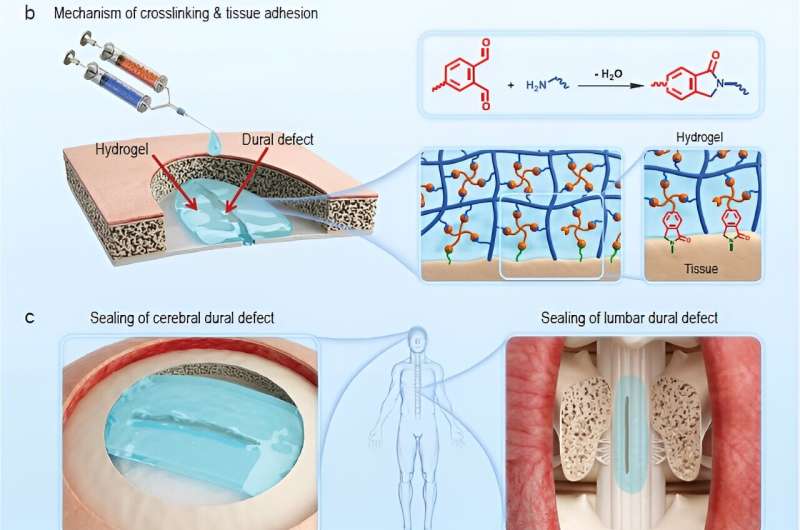This article has been reviewed according to Science X's editorial process and policies. Editors have highlighted the following attributes while ensuring the content's credibility:
fact-checked
trusted source
proofread
Researchers develop low-swelling hydrogel sealant with benefits for postop adhesion and dural defects

The dura mater is a fibrous membrane of connective tissue that covers the spinal cord and the brain. Many neurosurgeries that involve access to the underlying nervous tissues create defects in the dura mater, further resulting in cerebrospinal fluid (CSF) leakage.
CSF leakage can lead to severe complications, including postural headache, pseudodural cyst, dural fistula, cerebral/spinal hernia, meningitis, intracranial hemorrhage, epidural fibrosis, and postoperative adhesion. To achieve watertight closure, clinical treatment relies on suturing the defect area.
However, suturing is time-consuming and technically difficult, especially when the defects are in inaccessible areas. Suturing also causes damage to the dura mater, and needle holes pose additional challenges to achieving watertight closure.
In recent years, the development of tissue adhesives and sealants for sutureless wound closure, hemostasis and leakage-proof sealing has received widespread attention due to their advantages including convenience, decreased damage to tissues, and suitability for emergency situations.
In this work, an injectable, tissue-adhesive and low- swelling hydrogel sealant was developed based on o-phthalaldehyde (OPA)/amine chemistry for dural sealing and repairing. The hydrogel was formed by simply mixing gelatin and OPA-terminated 4-armed PEG (4aPEG-OPA). The study is published in the journal National Science Review.
The OPA groups of 4aPEG-OPA could react with amine groups on gelatin to form phthalimidine linkages, resulting in a stable cross-linking network with low-swelling properties. Meanwhile, the OPA groups could couple with amine groups on the tissue surface, which contributed to firm tissue adhesion of the hydrogel and watertight sealing of dural defects.
The adhesive strength of the 4aPEG-OPA/gelatin hydrogel on porcine casing was 79.9 ± 12.0 kPa, which was markedly higher than that of fibrin glue (22.4 ± 5.5 kPa). The burst pressure of the 4aPEG-OPA/gelatin hydrogel was 208.0 ± 38.0 cmH2O, surpassing the fluctuation level of postoperative CSF pressure (100 cmH2O for a standing adult).
In vitro swelling and degradation tests showed that the 4aPEG-OPA/gelatin hydrogel had a noticeably low swelling ratio (33.3% ± 5.0%), compared with commercially available dural sealants (50%–400%). In vivo rat and rabbit models showed that after administration to the lumbar and cerebral dural incisions, the 4aPEG-OPA/gelatin hydrogel effectively sealed the dural defects and prevented CSF leakage, without noticeable compression on the central nervous system.
Moreover, the treatment with the hydrogel reduced local inflammation, epidural fibrosis, and postoperative adhesion in the dural defect areas. Overall, these results demonstrated the strong potential of the 4aPEG-OPA/gelatin hydrogel as a multifunctional sealant for efficient sealing of dural defects and prevention of postoperative adhesion.
More information: Xueliang Cheng et al, A low-swelling hydrogel as a multirole sealant for efficient dural defect sealing and prevention of postoperative adhesion, National Science Review (2024). DOI: 10.1093/nsr/nwae160





















